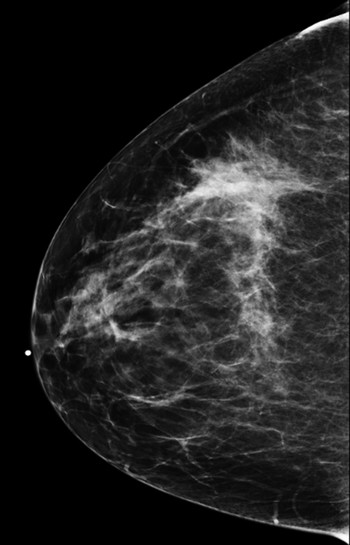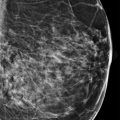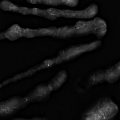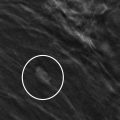Presentation and Presenting Images
( ▶ Fig. 88.1, ▶ Fig. 88.2, ▶ Fig. 88.3, ▶ Fig. 88.4)
A 55-year-old female with a palpable abnormality in her right axilla presents for diagnostic mammography.
88.2 Key Images
( ▶ Fig. 88.5, ▶ Fig. 88.6, ▶ Fig. 88.7, ▶ Fig. 88.8)
88.2.1 Breast Tissue Density
There are scattered areas of fibroglandular density.
88.2.2 Imaging Findings
The imaging of the left breast is normal and is shown for comparison ( ▶ Fig. 88.2 and ▶ Fig. 88.4). The palpable abnormality (triangular skin marker) in the right axilla corresponds with the abnormal lymph nodes (circle in ▶ Fig. 88.6 and ▶ Fig. 88.8). There is an area of architectural distortion (arrows) measuring 1.7 centimeters in the outer hemisphere of the right breast at the 9 to 10 o’clock location, 8 cm from the nipple ( ▶ Fig. 88.5 and ▶ Fig. 88.6). The digital breast tomosynthesis (DBT) movie confirms an area of architectural distortion in the right breast at the 9 o’clock location, 8 cm from the nipple ( ▶ Fig. 88.7 and ▶ Fig. 88.8).
88.3 Diagnostic Images
88.3.1 Imaging Findings
Ultrasound shows an abnormal level I lymph node ( ▶ Fig. 88.9) that corresponds to the largest lymph node seen on the mammogram. The lymph node has lost its parallel orientation, reniform shape, and echogenic fatty hilum. This lymph node has an appearance suggestive of a metastatic lymph node.
Ultrasound of the breast shows a hypoechoic spiculated mass (arrows in ▶ Fig. 88.10) measuring approximately 2 cm maximally at the 9 o’clock location. This mass corresponds to the architectural distortion seen mammographically.
88.4 BI-RADS Classification and Action
Category 5: Highly suggestive of malignancy
88.5 Differential Diagnosis
Invasive lobular carcinoma: A discrete mass is less commonly seen with invasive lobular carcinoma compared with invasive ductal carcinoma; instead, there is a higher incidence of subtle mammographic signs, such as asymmetry or architectural distortion.
Summation artifact: The architectural distortion is noted and persists on both the conventional and DBT imaging.
Radial scars: Radial scars may present as an area of architectural distortion. However, the abnormal lymph node makes this diagnosis a less likely possibility.
88.6 Essential Facts
Identifying invasive lobular carcinoma at screening mammography has been known to be a difficult task with false-negative rates ranging from 8 to 19%.
The difficulty of detection is secondary to the spread of invasive lobular carcinoma through the breast parenchyma in a single file fashion and the tendency of the cells to grow circumferentially around ducts and lobules causing minimal interruption of the fundamental anatomical structures of the breast.
Invasive lobular carcinoma presents more commonly as an asymmetry or an architectural distortion.
Invasive lobular carcinoma is commonly less dense than or isodense to normal breast tissue.
88.7 Management and Digital Breast Tomosynthesis Principles
DBT permits radiologists to scroll manually through the images or view the images as a movie and visualize the breast tissue in sections.
These cross-sectional tomosynthesis images (slices) allow better visualization of lesions because of the elimination of breast tissue overlap and the reduction of the masking impact of tissue density.
Architectural distortion is better seen and characterized on DBT than on conventional mammography.
DBT identifies a subset of architectural distortions that are not identified on conventional mammography. Identification of these additional architectural distortions increases the cancer detection rate.
88.8 Further Reading
[1] Helvie MA, Paramagul C, Oberman HA, Adler DD. Invasive lobular carcinoma. Imaging features and clinical detection. Invest Radiol. 1993; 28(3): 202‐207 PubMed
[2] Krecke KN, Gisvold JJ. Invasive lobular carcinoma of the breast: mammographic findings and extent of disease at diagnosis in 184 patients. AJR Am J Roentgenol. 1993; 161(5): 957‐960 PubMed
[3] Partyka L, Lourenco AP, Mainiero MB. Detection of mammographically occult architectural distortion on digital breast tomosynthesis screening: initial clinical experience. AJR Am J Roentgenol. 2014; 203(1): 216‐222 PubMed

Fig. 88.1 Right craniocaudal (RCC) mammogram.
Stay updated, free articles. Join our Telegram channel

Full access? Get Clinical Tree








